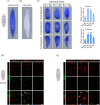MRLC controls apoptotic cell death and functions to regulate epidermal development during planarian regeneration and homeostasis
- PMID: 37357415
- PMCID: PMC10771114
- DOI: 10.1111/cpr.13524
MRLC controls apoptotic cell death and functions to regulate epidermal development during planarian regeneration and homeostasis
Abstract
Adult stem cells (ASCs) are pluripotent cells with the capacity to self-renew and constantly replace lost cells due to physiological turnover or injury. Understanding the molecular mechanisms of the precise coordination of stem cell proliferation and proper cell fate decision is important to regeneration and organismal homeostasis. The planarian epidermis provides a highly tractable model to study ASC complex dynamic due to the distinct spatiotemporal differentiation stages during lineage development. Here, we identified the myosin regulatory light chain (MRLC) homologue in the Dugesia japonica transcriptome. We found high expression levels of MRLC in wound region during regeneration and also expressed in late epidermal progenitors as an essential regulator of the lineage from neoblasts to mature epidermal cells. We investigated the function of MRLC using in situ hybridization, real-time polymerase chain reaction and double fluorescent and uncovered the potential mechanism. Knockdown of MRLC leads to a remarkable increase in cell death, causes severe abnormalities during regeneration and homeostasis and eventually leads to animal death. The global decrease in epidermal cell in MRLC RNAi animals induces accelerated epidermal proliferation and differentiation. Additionally, we find that MRLC is co-expressed with cdc42 and acts cooperatively to control the epidermal lineage development by affecting cell death. Our results uncover an important role of MRLC, as an inhibitor of apoptosis, involves in epidermal development.
© 2023 The Authors. Cell Proliferation published by Beijing Institute for Stem Cell and Regenerative Medicine and John Wiley & Sons Ltd.
Conflict of interest statement
The authors declare no competing financial interests.
Figures






Similar articles
-
Cdc42 regulate the apoptotic cell death required for planarian epidermal regeneration and homeostasis.Int J Biochem Cell Biol. 2019 Jul;112:107-113. doi: 10.1016/j.biocel.2019.05.008. Epub 2019 May 15. Int J Biochem Cell Biol. 2019. PMID: 31102665
-
Tubgcp3 is a mitotic regulator of planarian epidermal differentiation.Gene. 2021 Apr 5;775:145440. doi: 10.1016/j.gene.2021.145440. Epub 2021 Jan 19. Gene. 2021. PMID: 33482282
-
Two distinct roles of the yorkie/yap gene during homeostasis in the planarian Dugesia japonica.Dev Growth Differ. 2015 Apr;57(3):209-17. doi: 10.1111/dgd.12195. Epub 2015 Feb 24. Dev Growth Differ. 2015. PMID: 25708270 Free PMC article.
-
The role of the EGFR signaling pathway in stem cell differentiation during planarian regeneration and homeostasis.Semin Cell Dev Biol. 2019 Mar;87:45-57. doi: 10.1016/j.semcdb.2018.05.011. Epub 2018 May 18. Semin Cell Dev Biol. 2019. PMID: 29775660 Review.
-
Regeneration in an evolutionarily primitive brain--the planarian Dugesia japonica model.Eur J Neurosci. 2011 Sep;34(6):863-9. doi: 10.1111/j.1460-9568.2011.07819.x. Eur J Neurosci. 2011. PMID: 21929621 Review.
Cited by
-
Usp7 contributes to the tail regeneration of planarians via Islet/Wnt1 axis.J Transl Med. 2025 Jan 30;23(1):137. doi: 10.1186/s12967-025-06134-w. J Transl Med. 2025. PMID: 39885534 Free PMC article.
References
-
- Xie W, Zhou J. Regulation of mitotic spindle orientation during epidermal stratification. J Cell Physiol. 2017;232:1634‐1639. - PubMed
-
- Hombach S, Kretz M. The non‐coding skin: exploring the roles of long non‐coding RNAs in epidermal homeostasis and disease. BioEssays. 2013;35:1093‐1100. - PubMed
-
- Zhu SJ, Pearson BJ. Smed‐myb‐1 specifies early temporal identity during planarian epidermal differentiation. Cell Rep. 2018;25:38‐46.e33. - PubMed
MeSH terms
Substances
Grants and funding
LinkOut - more resources
Full Text Sources
Miscellaneous

